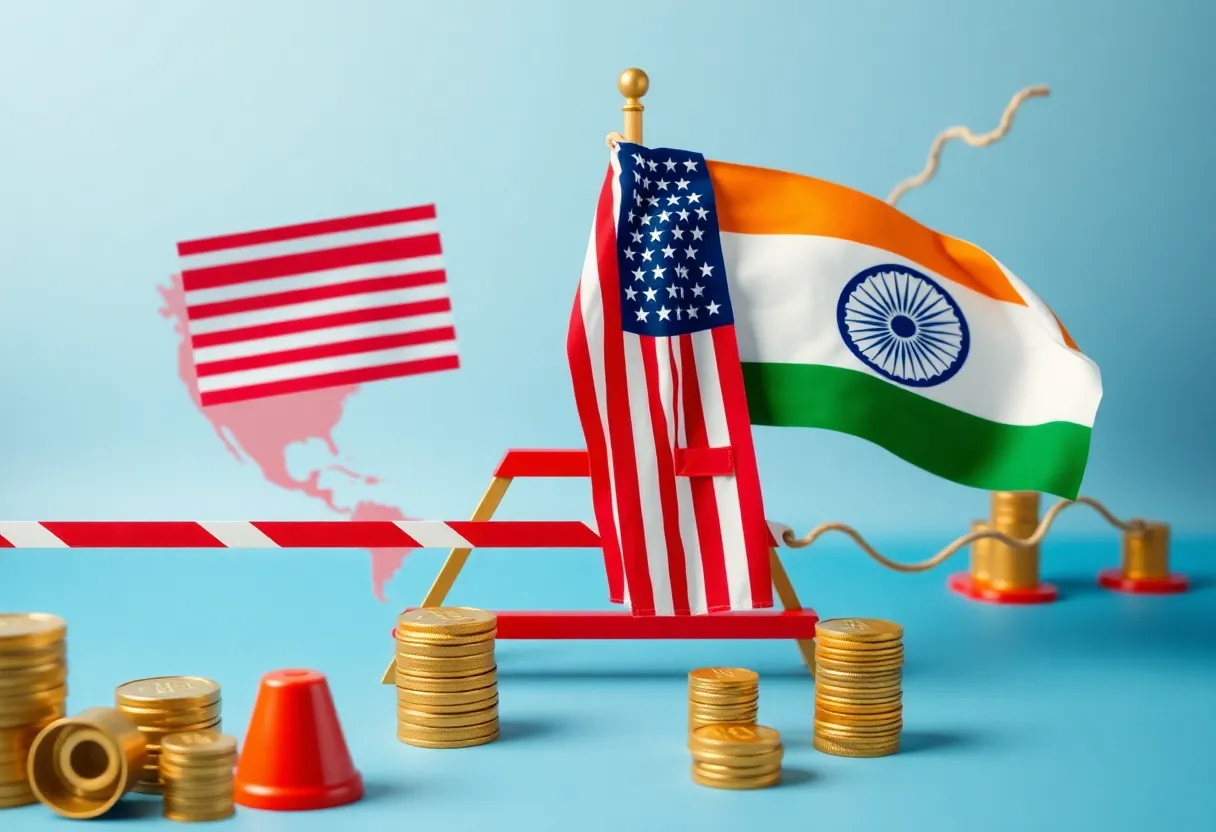News Summary
President Donald Trump has escalated tariffs on imports from India to 50%, doubling the previous rate of 25%. This decision aims to penalize India for purchasing oil from Russia amid ongoing global tensions. Analysts warn that this tariff increase may significantly strain US-India relations, which have historically been cooperative. Key sectors affected include pharmaceuticals and apparel, while fears about rising consumer prices and potential retaliatory measures from India loom large. The broader impact on trade dynamics and the tech industry remains a significant concern for both nations.
Trump Increases Tariffs on Indian Imports to 50%
In a bold move that has sent ripples through the international trade community, President Donald Trump has doubled the tariffs on imports from India to a staggering 50%. This escalation comes on the heels of a previous baseline tariff of 25% and is aimed at penalizing India for purchasing oil from Russia, amidst ongoing global tensions stemming from the conflict in Ukraine.
Impact on US-India Relations
This latest tariff increase raises eyebrows regarding the health of US-India relations, as India is considered one of America’s key trading partners. Historically, both nations have worked towards strengthening economic ties; however, with this aggressive tariff increase, the relationship could face significant strain. Analysts suggest that the trade deficit between the two countries has already widened over the past decade—while both nations have doubled their imports from one another, the US imported around $87 billion worth of goods from India in 2022, compared to approximately $42 billion in exports.
The Tariff Breakdown
The most notable products affected by the tariff hike include pharmaceuticals, communication equipment, and apparel—though it’s worth mentioning that smartphones are notably exempt from the 50% tariff. This sector-specific approach means that various tariffs won’t cumulatively add up; for instance, steel and aluminum tariffs are not combined, which could complicate financial estimations for businesses relying on these imports.
Consumer and Business Effects
American consumers and businesses are already feeling the impact of rising costs due to Trump’s tariff policies. With the increased tariffs on Indian goods, many worry about escalating prices on everyday products. Moreover, experts are concerned this trade escalation may lead to challenges such as job losses and slower economic growth in India. The Democratic US House Foreign Affairs Committee has even criticized Trump’s focus on tariffs against India, asserting that this could hurt American consumers and diminish bilateral relations.
India’s Response
In response to these new tariffs, India’s junior foreign minister, Kirti Vardhan Singh, indicated that the Indian government might retaliate against the US’s decisions. Additionally, India raised concerns that Trump’s selection of trade targets seems unjust—citing China, the largest buyer of Russian oil, as being exempt from similar penalties.
The Broader Trade Landscape
While Indian exports to the US could face an impact projected at around $48.2 billion, it is noteworthy that the tech industry has seen American companies like American Express, Microsoft, and Google expand their operations in India. This growth could be jeopardized if retaliatory measures are enacted in response to the tariffs.
Looking Ahead
India was one of the first nations to pursue trade negotiations with the Trump administration, but conflicting expectations—especially in areas like agriculture and dairy—have stalled any potential agreements. With the current political climate, both nations may need to rethink their strategies to avoid escalating tensions further.
FAQ Section
What are the new tariff rates on Indian imports?
The tariffs on imports from India have been increased to 50% from a previous rate of 25%.
What prompted the increase in tariffs?
The tariff increase aims to penalize India for its purchases of Russian oil amid the conflict in Ukraine.
How will this affect US-India relations?
This tariff escalation could strain the relationship between the US and India, which has historically been one of mutual trade cooperation.
What industries are most affected by these tariffs?
Key sectors affected include pharmaceuticals, communications equipment, and apparel. However, smartphones are exempt from these tariffs.
Will there be retaliatory measures from India?
India’s government has indicated it is prepared to retaliate against the US’s tariff increases, although specific measures have not yet been detailed.
Deeper Dive: News & Info About This Topic
- NDTV
- Wikipedia: Trade War
- Times of India
- Google Search: US-India trade tariffs
- The Guardian
- Google Scholar: Trump tariffs on India
- Washington Post
- Encyclopedia Britannica: Tariffs
- Reuters
- Google News: Trump tariffs

Author: STAFF HERE AUGUSTA WRITER
The AUGUSTA STAFF WRITER represents the experienced team at HEREAugusta.com, your go-to source for actionable local news and information in Augusta, Richmond County, and beyond. Specializing in "news you can use," we cover essential topics like product reviews for personal and business needs, local business directories, politics, real estate trends, neighborhood insights, and state news affecting the area—with deep expertise drawn from years of dedicated reporting and strong community input, including local press releases and business updates. We deliver top reporting on high-value events such as Arts in the Heart Festival, Westobou Festival, and Masters Week. Our coverage extends to key organizations like the Augusta Metro Chamber of Commerce and Greater Augusta Arts Council, plus leading businesses in manufacturing and healthcare that power the local economy such as Textron Specialized Vehicles, Cardinal Health, and Nutrien. As part of the broader HERE network, including HEREAtlanta.com and HERESavannah.com, we provide comprehensive, credible insights into Georgia's dynamic landscape.





